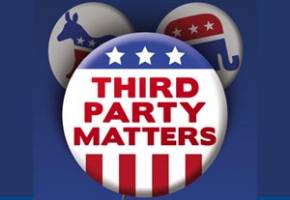Summary
This lesson analyzes the impact of minor political parties on national elections.
Essential Question(s)
How do third parties affect American government and society?
Snapshot
Engage
Students watch an advertisement for Johnson/Weld 2016 and complete an I Notice, I Wonder activity.
Explore
Students analyze voter turnout statistics related to four key presidential elections.
Explain
Upon discussion of the statistics, students read and analyze an article over third parties in the United States.
Extend
Groups of students create a poster presentation discussing the pros and cons of third parties.
Evaluate
Students use a Gallery Walk to view and critique posters and participate in an Exit Ticket activity.
Materials
Pens, pencils, markers, crayons
Poster board or butcher paper
"Third Parties in the U.S. Political Process" article
Voter Results handout (attached)
Notebook paper
Sticky notes
Engage
Display slide 5. Upon entering the classroom, students will be asked to watch an advertisement for 2016 Libertarian candidates, Gary Johnson and William Weld. While watching the ad (slide 6), students will complete an I Notice, I Wonder activity to jot down any observations or questions they have about what they are watching.
Following the video, display slide 7 and ask students to share their observations and questions with the class. Then, display slide 8 and pose a few questions (below). Call on volunteers to share out their thoughts.
What does it mean to be a third party in the United States?
How are third parties different from the Democratic and Republican parties?
What have you heard about third parties? What have you heard about third party candidates? Can you name any third party candidate (past or present) besides Johnson/Weld?
Do you think that third parties could have any impact on a national presidential election?
Explore
Next, students will receive the Voting Results handout. Display slide 9. Students will analyze the charts on the handout for any trends or interesting statistics.
Following the student analysis of the handout, display slide 10 and ask students to share out.
What trends do they see?
Would the elections have turned out any differently had the third party not been on the ballot?
What do you think was going on historically at the time of these elections?
How might those events have necessitated the inclusion of the third parties?
Explain
After students have analyzed past voting statistics, hand out the PBS article, "Third Parties in the U.S. Political Process" and display slide 11. While reading, students should complete a Why-Lighting activity to highlight key points and explain their understanding.
Once students have completed the reading, ask them to share what they highlighted (slide 12) and why they thought it was important.
If students do not mention highlighting the contributions of third parties, have them highlight those, too.
Extend
After reading and discussing the article, divide students into small groups of three to four. Display slide 13. Each group will be responsible for creating a poster that advertises the positive contributions (example: child labor laws) of third parties in the United States as well as possible negative impacts of these parties (example: election spoilers).
For each poster, students should identify a third party, a key change made as a result of that party, and a consequence of that party. Furthermore, students should include a visual in order to tie their advertisement together.
For example, one group may select to advertise the Populist Party. The Populists fought for many social changes, such as the 40-hour workweek, which we enjoy today. However, the Populist Party resulted in highly factionalized politics as well as a rise in tensions between industrial companies and industrial workers.
Evaluate
Upon completion of their posters, students will participate in a Gallery Walk to view each group's work (slide 14). As students view the work, each student should use a Post-it Note to provide feedback to the group.
After students return to their seat, ask them to reflect back on the questions from the Engage section. Display slide 15 and ask them to complete an Exit Ticket by selecting and responding to two of the questions from earlier.
Resources
Gary Johnson and William Weld 2016. YouTube Video. https://www.youtube.com/watch?v=LGD8gJt7weU
Leip, David. "1912 Presidential General Election Results". Copyright 2012, David Leip. http://uselectionatlas.org/RESULTS/national.php?year=1912
"Election of 1912". Copyright 1999-2016 - Gerhard Peters and John T. Woolley - The American Presidency Project. http://www.presidency.ucsb.edu/showelection.php?year=1912
K20 Center. I Notice, I Wonder. Strategies. https://learn.k20center.ou.edu/strategy/d9908066f654727934df7bf4f507d1a7
K20 Center. Why-Lighting. Strategies. https://learn.k20center.ou.edu/strategy/d9908066f654727934df7bf4f505e7d5
K20 Center. Gallery Walk / Carousel. Strategies. https://learn.k20center.ou.edu/strategy/d9908066f654727934df7bf4f505a54d
Nwazota, Kristina. "Third Parties in the U.S. Political Process". (2004, July 26). PBS NEWSNOW. Copyright 1996 - 2016, NewsHour Productions LLC. http://www.pbs.org/newshour/updates/politics-july-dec04-third_parties/
"The Living Room Candidate". Copyright 2016 Museum of the Moving Image. http://www.livingroomcandidate.org/


